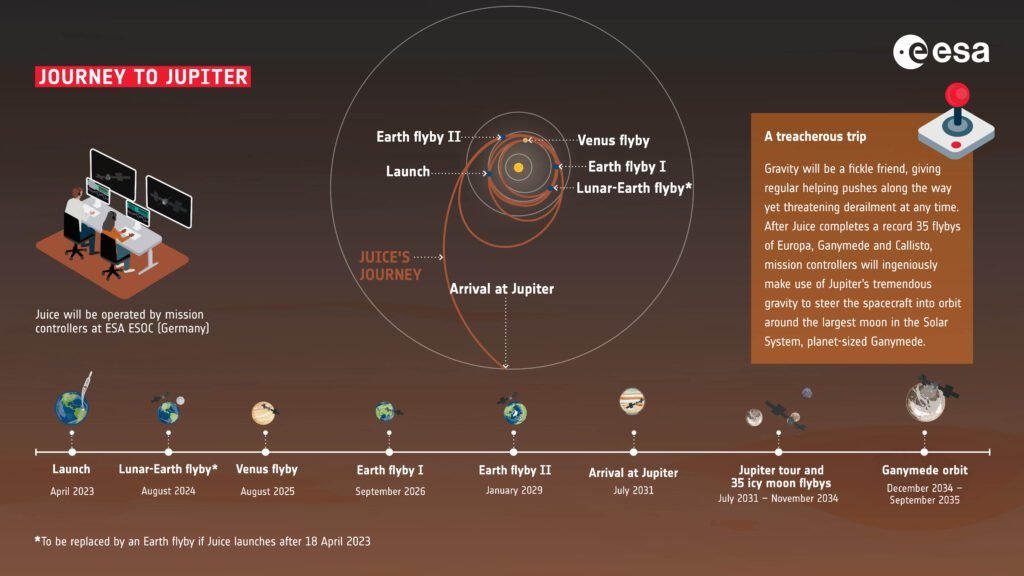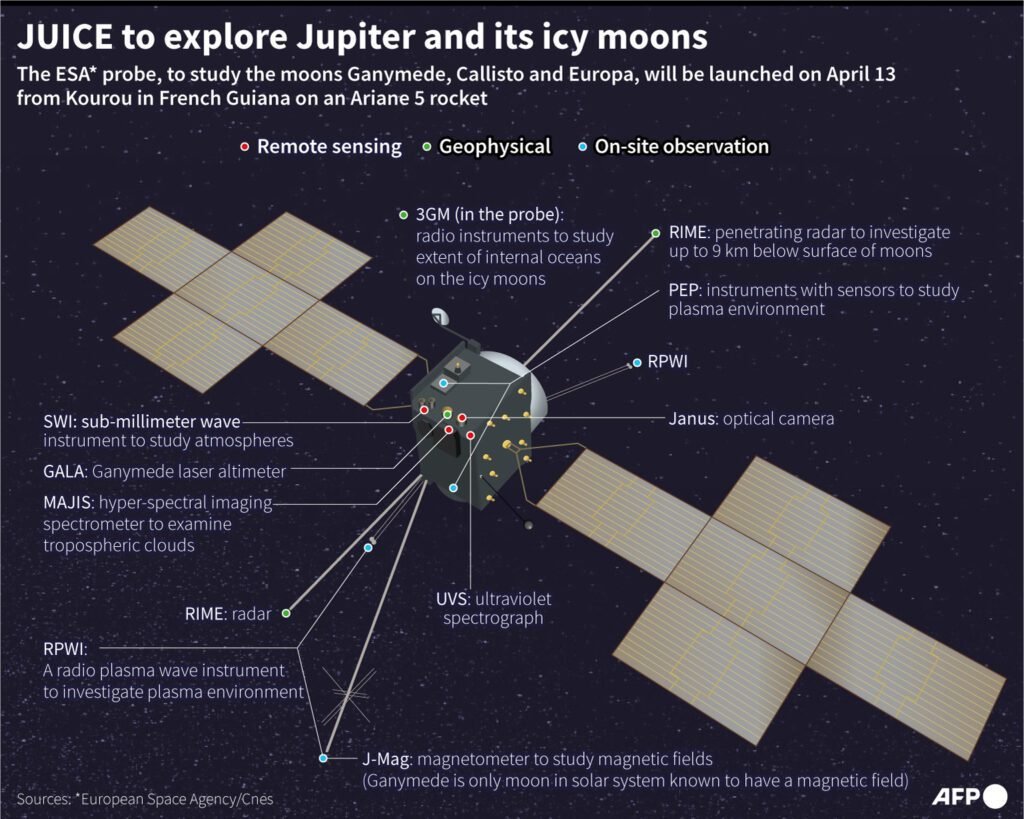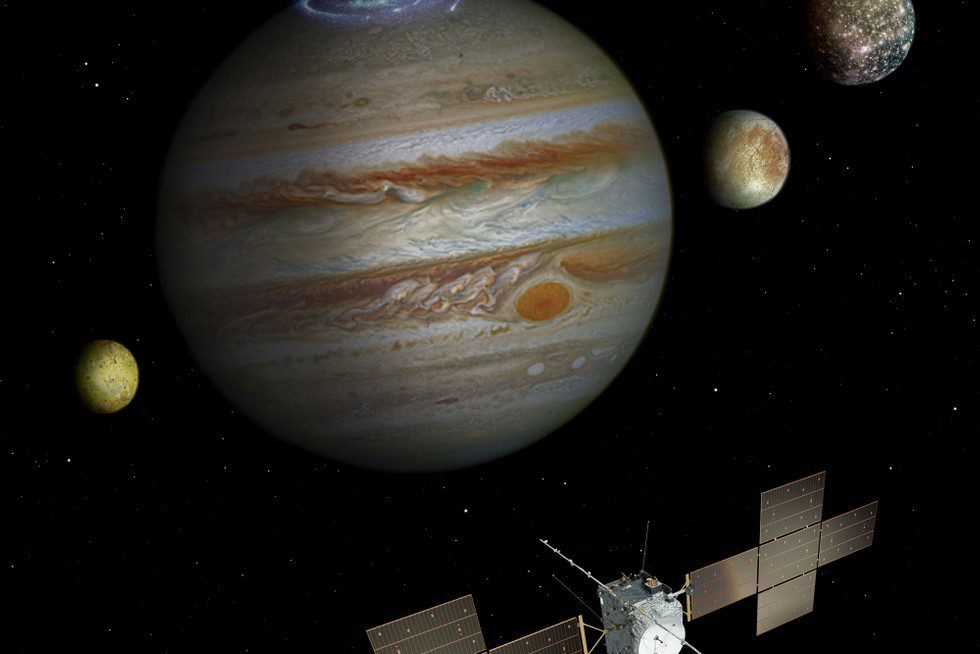JUICE is a long mission of European Space Agency (ESA), to explore Jupiter and it’s three biggest moons: Ganymede, Calisto and Europa.
Source: Space.com
The spacecraft will orbit the gas giant at the same time as NASA’s Europa Clipper mission, which will examine the habitability of another Jupiter moon, Europa. Approximately four years after its arrival at the Jupiter system, JUICE will move into orbit around the gas giant’s largest moon, Ganymede, to conduct the most extensive exploration of this body, which is larger than the solar system’s smallest planet, Mercury.


The importance of JUICE
Only two spacecraft have orbited Jupiter: the Galileo probe, which studied the gas giant between 1995 and 2003, and Juno, which has been circling the planet since 2016.
The Galileo mission found evidence that oceans of liquid water might exist underneath the ice crust of three of the four main Jovian moons: Europa, Ganymede and possibly Callisto. The mission also found that Ganymede has its own magnetic field — the only known moon to possess one — and that storms in Jupiter’s atmosphere can be larger than Earth.
Juno revealed many more details about these storms and found that the planet’s atmospheric weather layer extends beyond its visible clouds. The mission also discovered that a core of dilute heavy metals might hide within the mostly gaseous Jupiter.
Still, many questions about Jupiter and its moons remain unanswered, especially those regarding the potential of some of those bodies to host life. Together, JUICE and Europa Clipper are set to deepen our understanding of the Jupiter system and perhaps pave the way for a future mission to land on Europa.

What JUICE is going to do?
NASA’s Europa Clipper spacecraft will already be orbiting Jupiter when JUICE arrives, making regular dives as close as a few dozen miles from Europa’s surface, JUICE will focus mostly on Ganymede and the strange, less-explored Callisto.
It will make only two flybys of Europa, coming within 250 miles (400 kilometers) of the moon’s ice-covered surface during these excursions, according to ESA’s JUICE launch kit(opens in new tab). Europa orbits Jupiter at a distance of 417,000 miles (671,000 km), nearly double the moon-Earth distance. However, considering Jupiter’s extreme size and powerful magnetic field, any spacecraft would survive only a few months, at best, if it were to stay that close to the planet. NASA’s Europa Clipper also will follow the flyby approach to exploring this moon, making only brief visits to study the icy moon and surrounding environment.
JUICE will perform 21 flybys of the most distant of the four main moons, Callisto, getting as close as 120 miles (200 km) from its surface. Orbiting nearly 1.2 million miles (1.9 million km) from Jupiter, Callisto is a very different world than the lively Europa, which is believed to have water plumes squirting through its ice crust. At about the size of Mercury, Callisto is the second largest of Jupiter’s moons, and has a crater-riddled surface that scientists think is the oldest in the solar system. Scientists are unsure whether Callisto has a subsurface ocean like those of Europa and Ganymede, and JUICE is very likely to answer this question.
Before entering orbit around Ganymede, JUICE will perform 12 flybys of the moon, coming within 250 miles of the magnetically active body, according to the ESA launchkit. Ganymede lives between the orbits of Europa and Callisto, 665,000 miles (1.07 million km) from Jupiter, and scientists think the giant moon is much less likely than Europa to host life. There is, however, a small chance that JUICE may find a surprise.

According to news, the JUICE probe will confirm the existence of oceans on the moons, try to understand why Calisto has its own magnetic field and observe shape change on moons due to Jupiter’s gravity. Also, it will measure temperature and wind speeds on Jupiter’s atmosphere, to get new information about the climate. In addition to detect the planet’s chemical composition with more accuracy.


